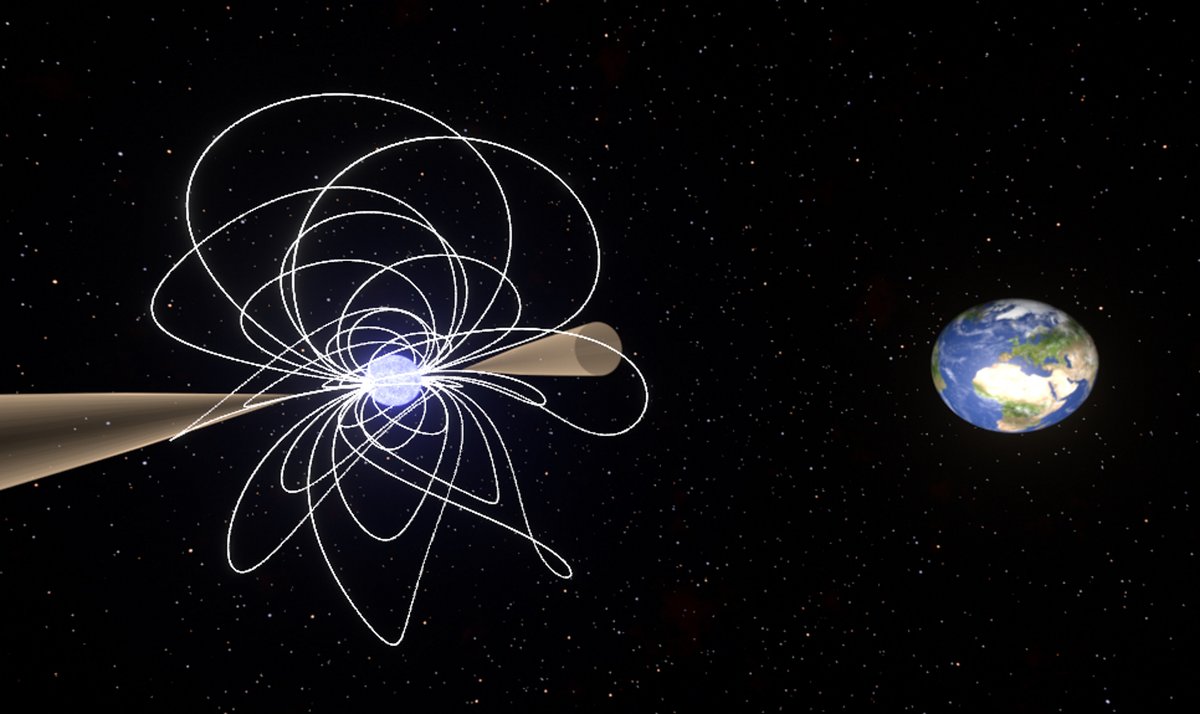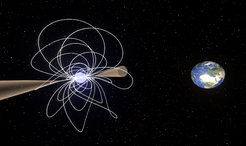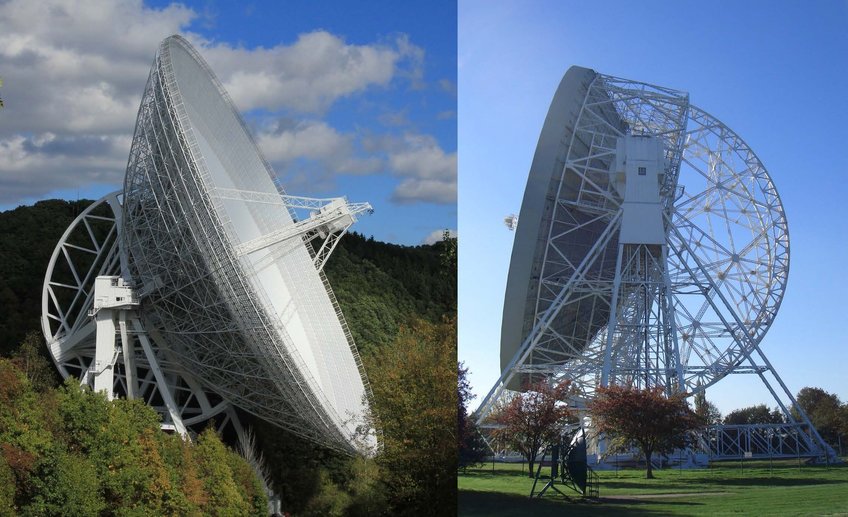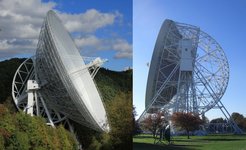The rapid decay of the magnetar precession after the X-ray burst would likely rule out the precession as a cause of radiation explosions
An international team of researchers led by Gregory Desvigny of the Max Planck Institute for Radio Astronomy in Bonn used the radio telescopes at Eifelsberg and Jodrell Bank to detect the magnetar XTE J1810-197 – a highly magnetized and extremely dense neutron star – shortly after its appearance. Enhanced X-ray activity and radio-radiation reactivation were observed. This precession is attenuated on a time scale of a few months, challenging some models used to explain the origin of mysterious rapid bursts of radio radiation.
© Gregory Desvins/MPIfR
An artist's conception of a moving magnetar with a twisted magnetic field, its radio beam aimed at Earth.
© Gregory Desvins/MPIfR
Magnetars are neutron stars with extremely strong, twisted magnetic fields, the remnants of the collapse of massive stars that have run out of fuel. These objects are so dense that they contain between one and two times the mass of the Sun in a near-perfect sphere with a radius of only about 12 km. Of the 30 magnetars known to date, only a few emit radio waves, their radio beams darting across the sky like a lighthouse. Magnetars are widely considered a source of fast radio bursts (FRBs), with some models pointing to freely advancing magnetars as the cause of FRBs.
In collaboration with colleagues from the Jodrell Bank Center for Astrophysics and the Kavli Institute for Astronomy and Astrophysics, researchers at the Max Planck Institute for Radio Astronomy (MPIfR) regularly examine some of these magnetars. They unexpectedly discovered a magnetar, XTE J1810-197, in December 2018, which began emitting radio again shortly after it began emitting enhanced X-rays and after a period of about ten years in which no radio emission could be detected.
When researchers launched an intensive monitoring campaign after this event, they observed very systematic changes in the properties of radio light, specifically in polarization, which revealed a shift in the direction of the magnet's radio beam relative to the Earth. The researchers attributed this to free motion, an effect caused by a slight asymmetry in the structure of the magnetar, which makes it sway like a top. To their surprise, this initiative quickly weakened over the next few months and eventually disappeared completely. The disappearance of precession over time contradicts the belief of many astronomers, who believe that fast radio bursts can be explained by repeated bursts of radio emission from past magnetars.
“We expected to see some differences in the polarization of this magnetar's emission because we knew this from other magnetars“Recalls Gregory Desvigny of MPIfR, lead author of the study.But we did not expect these fluctuations to be so regular, that they closely follow the behavior caused by the star's wobble.“
Patrick Weltifredi from the University of Manchester adds: “Our results were only possible because we observed this magnetar over many years using radio telescopes at Jodrell Bank and Eifelsberg. We had to wait more than a decade for it to start producing radio broadcasts, but when it did, it did not disappoint“.
“The damping precession of magnetars can shed light on the internal structure of neutron stars, which is ultimately linked to our fundamental understanding of matter.says Lijing Shao of Peking University.
“Radio astronomy is really cool! The mystery surrounding the origin of fast radio bursts remains. But capturing fascinating objects like magnetars to learn more about fast radio bursts highlights the capabilities of our facility.“, concludes Michael Kramer, Director of MPIfR and Head of the Fundamental Radio Astrophysics Research Section.
© Norbert Junks (Efelsberg Radio Telescope); Mike Bell (Lovell Telescope)
Two radio telescopes were used to make the observations for this post: the Effelsberg 100-meter radio telescope (left) and the Lovell 76-meter telescope at Jodrell Bank (right).
© Norbert Junks (Efelsberg Radio Telescope); Mike Bell (Lovell Telescope)
————————————————– —-
Background Information:
Authors of the original publication in Nature Astronomy are Gregory Desvigny, Patrick Weltfried, Yong Gao, Ian Jones, Michael Kramer, Manisha Kalb, Ramesh Karuppusamy, Lena Levin, Qu Liu, Andrew Lin, Lijing Xiao, and Ben Stubbers. Gregory Desvigny, the first author, along with Michael Kramer, Ramesh Karuppasamy, and Qu Liu work at MPIfR.

“Prone to fits of apathy. Zombie ninja. Entrepreneur. Organizer. Evil travel aficionado. Coffee practitioner. Beer lover.”









More Stories
Pokémon Go Hyperbonus Raid Day with Mega Lucario – Here’s What You Need to Know
Researcher warns of fire in space – “one of the most dangerous scenarios in space travel”
Gamescom 2024: Asus partners with Webedia